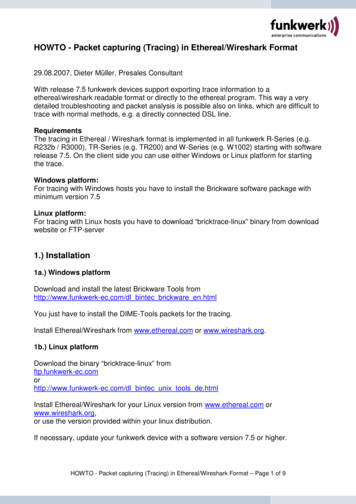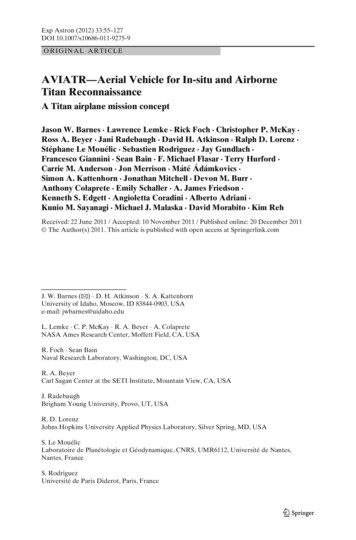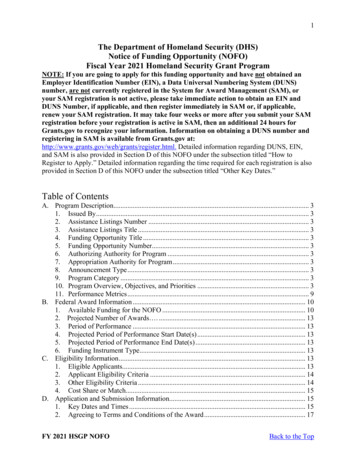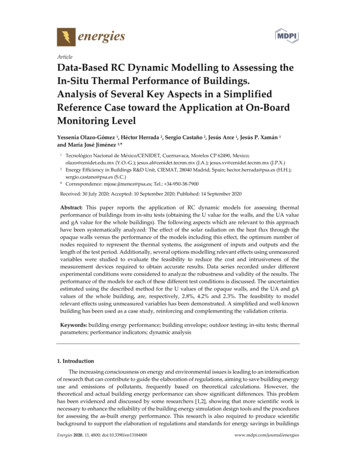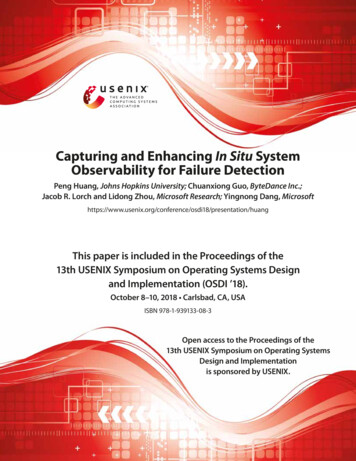
Transcription
Capturing and Enhancing In Situ SystemObservability for Failure DetectionPeng Huang, Johns Hopkins University; Chuanxiong Guo, ByteDance Inc.;Jacob R. Lorch and Lidong Zhou, Microsoft Research; Yingnong Dang, presentation/huangThis paper is included in the Proceedings of the13th USENIX Symposium on Operating Systems Designand Implementation (OSDI ’18).October 8–10, 2018 Carlsbad, CA, USAISBN 978-1-939133-08-3Open access to the Proceedings of the13th USENIX Symposium on Operating SystemsDesign and Implementationis sponsored by USENIX.
Capturing and Enhancing In Situ System Observabilityfor Failure DetectionPeng HuangJohns Hopkins UniversityChuanxiong GuoByteDance Inc.Jacob R. LorchLidong ZhouMicrosoft ResearchYingnong DangMicrosoftAbstractReal-world distributed systems suffer unavailability dueto various types of failure. But, despite enormous effort,many failures, especially gray failures, still escape detection. In this paper, we argue that the missing piecein failure detection is detecting what the requesters of afailing component see. This insight leads us to the designand implementation of Panorama, a system designed toenhance system observability by taking advantage of theinteractions between a system’s components. By providing a systematic channel and analysis tool, Panoramaturns a component into a logical observer so that it notonly handles errors, but also reports them. Furthermore,Panorama incorporates techniques for making such observations even when indirection exists between components. Panorama can easily integrate with popular distributed systems and detect all 15 real-world gray failures that we reproduced in less than 7 s, whereas existingapproaches detect only one of them in under 300 s.1IntroductionModern cloud systems frequently involve numerouscomponents and massive complexity, so failures arecommon in production environments [17, 18, 22]. Detecting failures reliably and rapidly is thus critical toachieving high availability. While the problem of failure detection has been extensively studied [8, 13, 14, 20,24, 29, 33, 34, 47], it remains challenging for practitioners. Indeed, system complexity often makes it hard toanswer the core question of what constitutes a failure.A simple answer, as used by most existing detectionmechanisms, is to define failure as complete stoppage(crash failure). But, failures in production systems canbe obscure and complex, in part because many simple failures can be eliminated through testing [49] orgradual roll-out. A component in production may experience gray failure [30], a failure whose manifestation is subtle and difficult to detect. For example, aUSENIX Associationcritical thread of a process might get stuck while itsother threads including a failure detector keep running.Or, a component might experience limplock [19], random packet loss [26], fail-slow hardware [11, 25], silenthanging, or state corruption. Such complex failures arethe culprits of many real-world production service outages [1, 3, 4, 6, 10, 23, 30, 36, 38].As an example, ZooKeeper [31] is a widely-used system that provides highly reliable distributed coordination. The system is designed to tolerate leader or follower crashes. Nevertheless, in one production deployment [39], an entire cluster went into a near-freeze status(i.e., clients were unable to write data) even though theleader was still actively exchanging heartbeat messageswith its followers. That incident was triggered by a transient network issue in the leader and a software defectthat performs blocking I/Os in a critical section.Therefore, practitioners suggest that failure detectionshould evolve to monitor multi-dimensional signals of asystem, aka vital signs [30, 37, 44]. But, defining signalsthat represent the health of a system can be tricky. Theycan be incomplete or too excessive to reason about. Setting accurate thresholds for these signals is also an art.They may be too low to prevent overreacting
ferentiates Panorama from traditional distributed crash failure detection services [34, 47], which only measure superficial failure indicators. In applying Panorama to real-world system software, we find some common design patterns that, if not treated appropriately, can reduce observability and lead to mis-leadingobservations.


